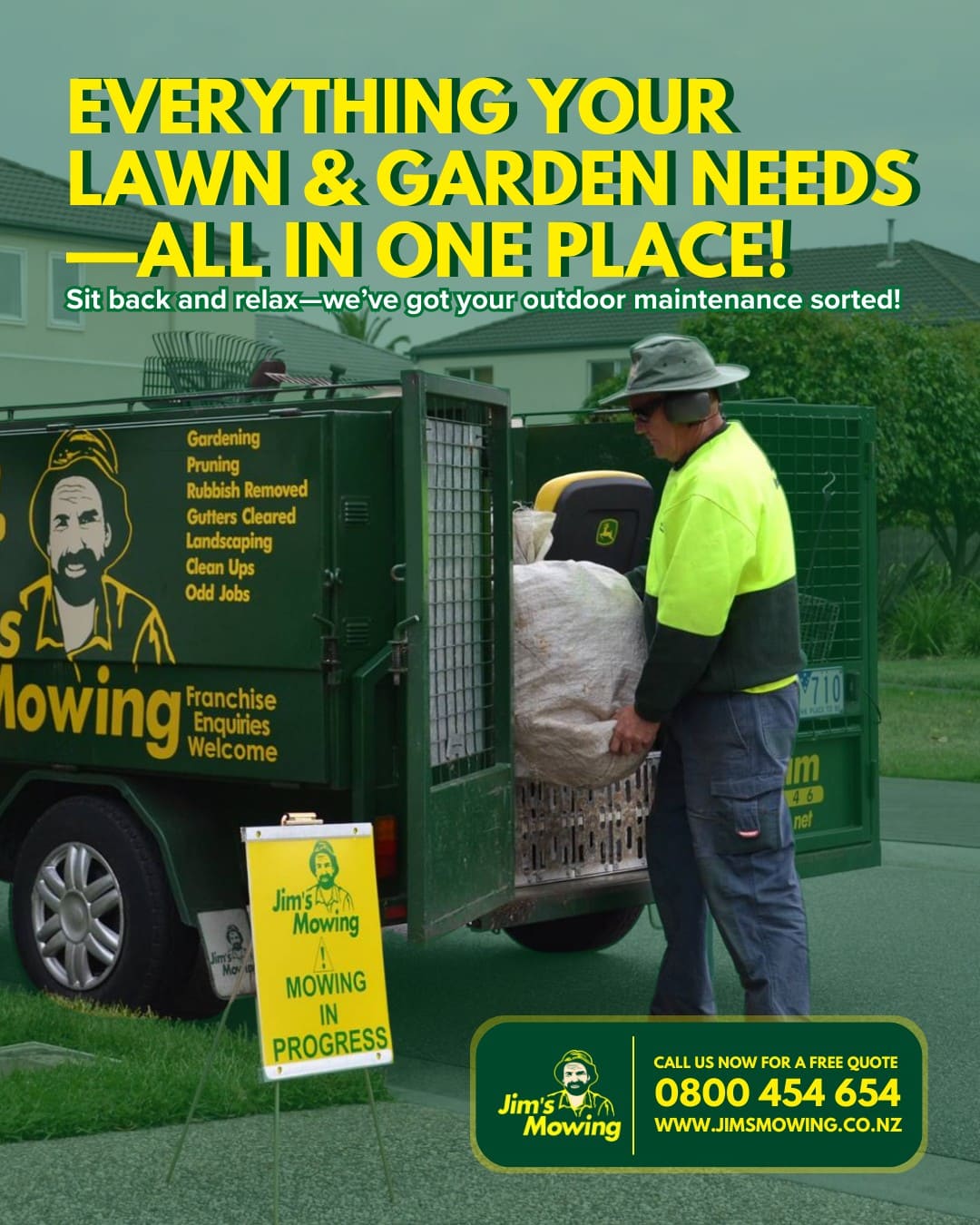A Jim’s Mowing NZ Guide to Basil Companion Plants
We all love the sweet, aromatic, peppery hit of fresh basil. It’s the essential ingredient for a perfect pesto, a classic caprese salad, or simply scattered over a homemade pizza. As a cornerstone of the Kiwi summer garden, getting the most out of your basil crop is a top priority.
But what if we told you the key to lusher, more flavourful basil, fewer pesky bugs, and healthier neighbouring plants, isn’t just about good soil and sunshine? It’s about who you plant your basil next to.
Welcome to the world of companion planting, a natural, age-old gardening technique that turns your garden into a powerful, cooperative ecosystem. And when it comes to basil, this technique is nothing short of magic.
At Jim’s Mowing NZ, we’re here to give you the ultimate guide to basil companion plants. Which are its best mates for a bumper harvest, from the subtropical Northland to the cooler climes of Otago.
In this blog you’ll learn:
- What is Companion Planting
- What are Basil’s Best Companion Plants
- What flowers are great to plant with Basil
- Which plants to avoid planting next to Basil
- FAQs about basil companion planting
What is Companion Planting and Why Does Basil Love It?

Companion planting is the practice of strategically placing different species of plants close to each other to help them thrive. It’s gardening with a team approach.
For basil, companion planting offers four primary, game-changing benefits:
- Natural Pest Control: Basil’s powerful aroma, particularly with its high essential oil content, acts as a natural insect repellent. When planted strategically, it can confuse and deter common New Zealand garden villains like whitefly, aphids, and the dreaded tomato hornworm (or the caterpillars of the endemic tomato fruitworm).
- Flavour Improvement: Legend has it that planting certain herbs together can enhance the flavour and essential oil production of nearby plants.
- Improved Growth and Health: Some companions improve the soil or provide necessary shade for basil on scorching summer days.
- Weed Suppression & Mulching: Low-growing plants can act as a living mulch, suppressing weeds and keeping the soil cool and moist—just the way basil likes it.
Basil’s Best Mates – The Essential Vegetable Companions

Basil is generally a good team player, but it has a few famous pairings that every Kiwi gardener should know.
1. Basil and Tomatoes
This is the most famous and arguably the most important basil companion pairing. It’s a match made in gardening heaven (and in the kitchen!).
- How They Help Each Other: Basil’s strong scent is particularly effective at repelling whiteflies and the caterpillars of the tomato fruitworm – two pests that love to feast on tomato plants. Studies also suggest that basil can improve the flavour and vigour of the tomatoes themselves. Both plants love the same conditions: hot sun, rich soil, and consistent watering, making them perfect neighbours.
- Jim’s Mowing Tip: For maximum pest control, many seasoned gardeners recommend planting at least one basil plant for every tomato plant, or scattering small groups of basil throughout your tomato rows.
2. Basil and Capsicum/Peppers
Just like tomatoes, capsicums and chillies are from the same plant family and have identical growing needs to basil.
- How They Help Each Other: Basil helps to deter the same pests that target peppers. By sharing a bed, you simplify your watering and feeding regime, as both plants thrive under the same hot, consistent conditions. The bushier growth of basil can also help to shelter the soil around the capsicum roots.
3. Basil and Cabbages/Broccoli
Brassicas (like cabbage, broccoli, and cauliflower) are constantly under attack from the Cabbage White Butterfly (Pieris rapae) whose caterpillars can skeletonise leaves overnight.
- How They Help Each Other: Planting basil nearby helps to confuse and deter the adult White Butterfly from laying its eggs on your brassicas. This aromatic interference is a wonderful, chemical-free way to protect your spring and summer crops.
4. Basil and Lettuce
Lettuce is a short-season crop that is a great fit for the base of your taller basil plants.
- How They Help Each Other: Lettuce is an ideal “living mulch.” Planted densely around the base of your basil, it keeps the soil cool and moist (which basil loves) and suppresses weeds. Because lettuce has shallow roots, it won’t compete with the deeper root system of your basil plant.
5. Basil and Carrots/Radishes
Root vegetables grow below the soil line, which means they don’t compete with basil for sunlight or above-ground space.
- How They Help Each Other: Basil’s foliage provides a good canopy of shade, which is particularly beneficial for keeping the soil cool for carrots and radishes during the peak of the New Zealand summer. This close companionship also helps with general garden health and deterring pests like the carrot rust fly.
Floral Allies: Basil’s Beneficial Flower and Herb Companions

Companion planting isn’t just about vegetables—some flowers and herbs are your basil’s secret weapons against garden bugs and allies for general health.
The Pest-Fighter Trio
- Marigolds (Tagetes spp.)
These sunny flowers are a powerhouse. They repel harmful soil nematodes (microscopic worms) that can damage plant roots and also deter various flying insects with their strong scent. Plant these annuals widely; they thrive in the same sunny spots as basil.
- Nasturtium
This is a classic “trap crop.” Aphids and caterpillars simply cannot resist them. By planting Nasturtiums nearby, you attract the pests away from your precious basil and other vegetables. You can sacrifice the Nasturtium to save your basil. Bonus: the leaves and flowers make a peppery, edible addition to your salads!
- Chives and Garlic
These pungent alliums are another excellent choice. Their strong, sulphuric scent helps to repel common pests like aphids, and they are also thought to help ward off fungal diseases.
The Pollinator Pals
- Borage
Crowned with beautiful, edible blue, star-like flowers, Borage is a magnet for essential pollinators, especially bees. More importantly, it attracts beneficial insects like ladybirds and predatory wasps (which eat aphids). Its deep roots also help to draw up trace minerals, improving the health of nearby basil.
- Oregano and Parsley
These two herbs share similar growing requirements (full sun, good drainage) and are great at attracting beneficial insects and pollinators to the area, boosting the overall health of your garden ecosystem.
The Non-Negotiables – What to AVOID Planting with Basil
Not all plants are a good fit. Some will stunt your basil’s growth or compete for resources. Keep basil well away from the following:
- Fennel
A notorious garden tyrant. Fennel produces a chemical that inhibits the growth of many other plants, including basil. Give it its own space!
- Rue
The herb Rue is an enemy of basil. Planting them together is said to hinder the growth and overall health of both plants.
- Cucumbers
While some gardeners report success, others find that cucumbers and basil compete too much for water and nutrients, sometimes leading to poor basil growth. Given the choice, it’s generally better to pair basil with the less thirsty tomato or capsicum.
Getting Started with Basil Companion Planting Your Garden

Basil is a warm-weather plant, best sown in New Zealand from late Spring through to early Autumn (typically October through to March) when the risk of frost is gone.
- Plan Your Layout – When designing your vege patch for the summer, mark out where your tomatoes, capsicums, and cabbages will go. Plant your basil seedlings or seeds 30-40cm apart, interspersing them among your companion crops rather than just grouping them all at the end of the bed.
- Interplant, Don’t Just Group – For maximum pest repellent effect, mix your basil within the rows of your vulnerable plants. A “pepper-basil-pepper” pattern is more effective than “pepper-pepper-pepper-basil.”
- Watering is Key – Basil needs consistent moisture, especially during dry spells. Ensure your companion plants (like tomatoes) which also require consistent water are planted with your basil to simplify your watering routine. Use a good quality compost and a layer of organic mulch to keep water in the soil.
- Regular Pruning – Pinch out your basil tips regularly to encourage bushier growth, which provides more protective aroma and a bigger harvest for your kitchen.
In Summary
A healthier garden, the Jim’s Mowing way, is about smart, natural solutions. Companion planting with basil is a simple, organic, and incredibly rewarding method that reduces your reliance on chemical controls. It works by bringing your garden into a natural, harmonious balance.
If you’re unsure about soil quality, need a hand with lawn care to give your basil bed the star treatment it deserves, or simply want to chat about your gardening plans, the local experts at Jim’s Mowing NZ are here to help. We’re passionate about healthy, beautiful Kiwi gardens—and that starts with a thriving vege patch!
Happy planting, and enjoy that delicious basil!
Frequently Asked Questions (FAQ)
Q: Why is my basil going to seed (flowering) so quickly?
A: This is called “bolting,” and it’s your basil plant’s natural reaction to stress, usually heat or lack of water. Once it flowers, the leaves can turn bitter.
- The Fix: Water consistently, especially during hot spells. Most importantly, regularly pinch or cut off the growing tips and any flower spikes as soon as they appear. This forces the plant to focus its energy on producing more delicious leaves instead of seeds.
Q: What is the best type of basil to grow in a New Zealand summer?
A: The most popular and reliable variety is ‘Sweet Basil’ or ‘Genovese Basil’. It has large, glossy leaves perfect for pesto and Italian cooking.
- If you’ve had issues with common diseases, look for a new, disease-resistant variety like ‘Prospera’ or ‘Everleaf Emerald Towers’.
- For Asian cuisine, try ‘Thai Basil’, which has a distinct, anise-like (licorice) flavour and holds up well to high heat cooking.
Q: My basil leaves have small holes. What’s eating them?
A: Small holes are usually caused by a few culprits:
- Caterpillars: Often the small green ones. Handpick them off or use a targeted organic insect spray.
- Slugs and Snails: Check the leaves, especially near the soil, for telltale silvery trails. A shallow dish of beer sunk into the soil or organic pellets can help.
- Flea Beetles: Tiny, jumping beetles that leave “shot-hole” damage.
Q: Can I grow basil in a pot or indoors?
A: Absolutely! Basil does very well in pots.
- Pot Size: Use a decent-sized pot (at least 20cm diameter) with good drainage.
- Indoors: Place the pot on your sunniest windowsill. If it starts to look “leggy” (stretching tall and thin), it needs more light.
Q: Can I still use the basil leaves if the plant has flowered?
A: Yes, the leaves are still edible, but their flavour will be less sweet and more pungent or slightly bitter. The younger leaves near the bottom will generally taste better than the older ones near the flower spike. You can also use the flowers as an edible garnish in salads!











